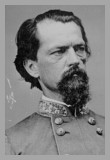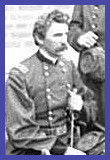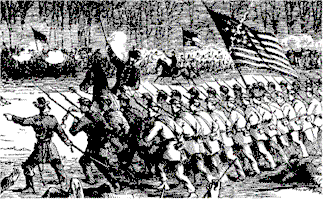| Lee
understood that he could not simply await the coming of
spring and Grant's main effort, but his options were
limited by his own limited means. Nonetheless, he had to
try something, and the result was the attack on Fort
Stedman. The concept reveals the desperate straits in which Lee found himself. He would throw a large fraction of his army on a narrow front against Grant's lines, hoping to achieve a breakthrough that would compel Grant to withdraw troops from his extended lines, and this contraction might allow Lee to escape from the Petersburg lines with enough of a head start to enable him to form a junction with Joe Johnston's army in North Carolina. This, at least, is the standard way that the story is presented. It perhaps reveals the circumstances in which the Confederates found themselves that this was considered to be their best remaining option. The actual tactical planning and execution were entrusted to John B. Gordon, commander of what was left of the old Second Corps. Gordon's plan, presented to Lee on March 22, was actually a sound one for an operation of less ambitious goals. To support him, Lee gave Gordon troops from both Hill's and Longstreet's corps, to the extent that Gordon had control of about half the army. Since large numbers of Confederate troops routinely deserted each night, Gordon would have his assault wave preceded by a collection of men masquerading as deserters. (The Federal policy was to pay each man $10 for his weapon, so it was not even uncommon to see deserters come in with the muskets in hand.) This would allow them to close with and neutralize the Federal pickets and thereby prevent the main Federal line from being alerted. The attacking force would be led by about 50 men with axes, detailed to chop away the Federal abatis and chevaux-de-frise. The initial objective was Fort Stedman, a solitary enclosed redoubt considered by Col. Henry Abbott, the Federal officer in charge of siege operations, as one of the weak links in the Federal lines. It was located on the right of the Federal lines near the Appomattox River, had no abatis, and was only 150 yards from the Rebel trenches. Once it was secured, the lines would be swept left and right to prevent the adjacent works from firing on the Confederates at Fort Stedman, and three columns of picked men would assail a set of redoubts which backed up Fort Stedman. Gordon even had at his disposal some of the Confederate cavalry which was supposed to pass through the opening in the lines to cause havoc in the Federal rear, possibly even reaching the Federal supply and nerve center at City Point. Fort Stedman was located near three Federal redoubts, Battery X, to the north, and Batteries XI and XII to the south. All four were located within a 1,000 yard section of the Federal line. The next supporting works to the north were Batteries IX and VIII, and Fort McGilvery, about 2,000 yards from Fort Stedman; and Fort Haskell, about 1,500 yards to the south. Simple trench lines and rifle pits connected the forts and redoubts. The attack was made at 4:00 in the morning of March 25, and was initially successful, in that Fort Stedman fell quickly along with the three nearby batteries. (Maj. William Miller, IX Corps Inspector of Artillery, was sent over towards Fort Stedman to check out the situation. He started giving orders in the dark to the men in the fort before he realized they were wearing a different uniform and he was taken prisoner.) However, the Rebels were unable to exploit this success. The supporting redoubts in the second line could not be found to be assaulted. The columns detailed to attack the adjacent works were quickly contained at Battery IX to the north and Fort Haskell to the south. This left the Rebel breakthrough limited to the immediate vicinity of Fort Stedman with the result that a killing fire was directed into the Rebel ranks from three sides, as well as the ground over which they would have to retreat in order to reach their own lines. Moreover, Brig. Gen. John Hartranft, commanding 3/IX, reacted promptly and with great strength; he quickly had troops closing in on three sides of the Confederate lodgement. The 200th Pennsylvania repulsed a brief effort by the Confederates to advance eastward from Fort Stedman, and then other regiments formed on the left and right of the 200th to connect with portions of the Yankee line still being held. At about 7:45 Hartranft --- who would be breveted a major-general of volunteers for his work this day --- began to launch a counterattack to expel the enemy force. Led by the 211th Pennsylvania, the Federal line rolled forward against wavering Confederate resistence. With his attack stalled and no hope of reaching City Point, Gordon realized that it was time to withdraw his men. This was difficult to do, however, because the ground between the lines was now swept with fire by the Federals -- a situation not unlike that which had contributed to so much Federal misery eight months earlier at the Crater. By 8:15, IX Corps commander Maj. Gen. John G. Parke was reporting to Meade's headquarters that Fort Stedman had been reoccupied. Over 1,900 Rebels were taken prisoner by the time the attack was over, and Lee's total losses are estimated at between 2,700 and 4,000. Federal losses (killed, wounded, missing) were about 1,000. These were losses that Lee could ill afford. Grant's reaction was swift and typical. Correctly reasoning that Lee must have weakened his line in order to make this effort, he ordered that the Confederate lines be probed for weak points. While no general assault was made as a result of this, both the II and VI Corps were able to take and hold the Confederate picket line along most of their corps front, precipitating a series of fights that cost the Federals an additional 1,200 men (approximately) and the Confederates perhaps as many as 1,600. While seemingly a modest achievement, this would have dire consequences for Lee and the Confederacy within a week. |
|
||
|
Return to Siege main page. Return to list of accounts. Go to previous page. Go to next page. |




